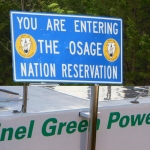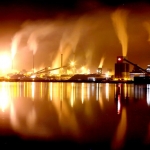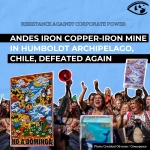Enron: Pulling the Plug on the Global Power Broker
On December 4, 2001, Enron filed for bankruptcy. Not long ago Enron was the largest energy trader in the world, the largest natural gas pipeline owner in the country and a pioneering force behind energy deregulation. The move resulted in 4,500 layoffs, or 60% of Enron's workforce at its headquarters in downtown Houston.
Employees and investors were stunned. How could one of the most wealthy and powerful corporations in the world go bust over night? Wall Street shuddered; could this be the first in a series of corporate disasters that marked the now official US recession?
In Houston, security guards patrolled the Enron buildings, watching employees as if they were potential thieves as they emptied their desks. Workers flooded into the streets in front, many crying and hugging one another as police on horseback shouted at them to disperse.
"My group was told nothing yesterday, other than to gather personal belongings and leave" former Enron employee Kathleen Salerno wrote in a letter to the Houston Chronicle. "On November 30, we were given the right to move Enron's matching funds for our retirement savings plans from Enron stock to another fund. My personal account amounted to $46.01. Another friend, with almost twenty years service had $102. This is absurd, sad, and I think, criminal."
A Vietnamese-American worker compared the Enron's demise to the fall of Saigon in 1975. "I watched the fear in the eyes of the South Vietnamese soldiers as they retreated and disposed of their weapons. I watched families and friends hugging each other for comfort as they waited in fear for the uncertainties which were about to fall on them. Last Monday those memories came flooding back. I saw chaos and confusion. I saw co-workers and friends hugging one another for comfort."
It was a far cry from previous years when Enron high flyers bought silver Porsches -- the most favored status symbol at the company -- to celebrate annual bonuses as high as $1 million. The company's stock soared to $90 a share at its peak last August, making it the seventh largest business in the United States. For five years in a row Enron was named "The Most Innovative Company in America" by readers of Fortune magazine.
Enron's Empire
Enron was founded in 1985 by Kenneth Lay, a former employee of the now defunct Federal Power Commission and an erstwhile economist at the Pentagon during the Vietnam War. The company was created when Lay merged Houston Natural Gas with InterNorth, a natural gas company based in Nebraska.
Over the years Lay invested millions of dollars in lobbying federal officials and financing their political campaigns to get them to privatize and deregulate the energy industry. In 1989 Enron began trading natural gas commodities to help utility customers shield themselves from risk by locking up the long-term prices that they wanted ahead of time. Enron bought the gas supplies from producers, arranged for delivery and took a cut of every deal.
In time, the company became the largest natural gas merchant in North America and the United Kingdom. This success in the natural gas industry soon made Enron believe it could apply these tactics of deregulation and political influence to a dizzying array of businesses from internet broadband to water, coal and steel. The Economist magazine described Enron as an "evangelical cult," with Ken Lay its "messiah."
This expansion was overseen by Jeffrey Skilling, a former energy consultant at McKinsey & Company, who joined Enron in 1990. Skilling transformed the company into the biggest and most aggressive of the new breed of unregulated energy traders that bought and sold billions of dollars of electricity and other commodities daily.
But instead of bringing prices down for buyers, these transactions had the effect of driving up prices to hundreds of times of production costs, pushing states like California into major debt.
"We are on the side of angels," Skilling, who was appointed chief executive officer of Enron early this year, told a television crew. He dismissed those who saw the company as a profiteer in California's energy crisis. "People want to have open, competitive markets. They want fair competition. It's the American way."
The Emperor Has No Clothes
Then, in mid-August Skilling was forced out of his job, cashing in his shares and options, pocketing some $62 million, while Lay cashed in stock worth $150 million. Two months later the company disclosed it had some internal financial problems and Enron's share price started to spiral downward even faster than it had risen.
Carl Wood, a member of California's energy commission, wryly remarked that Enron had turned out to be "all hat and no cattle -- that's their Texas expression."
Employees were far more bitter. A former Enron employee wrote in the Houston Chronicle that Skilling once said, "'Enron's strategy is simply to take the money outside the building and move it inside the building.' The smartest thing Skilling ever did: leave the building, and take the money with him."
Others, like George Strong, a lobbyist who worked for Enron for 25 years, say that Skilling brought arrogance and greed to the company. "We were looking to do a deal to supply energy to HISD (Houston's public school district), and I explained to them that it would take a year to educate the school district and make it comfortable with changing the way it got its power," says Strong. "The guy I was working with -- he was a director in his late 30s -- started yelling, 'I don't have a year! My bonus is based on what I do this quarter. If I can't get it done in three months, I don't have time for it.'"
Yet even though the boom in new markets and transactions inflated Enron's revenue and made for fat bonus checks, the company was still paying out more than it was bringing in. So Enron's accountants used complex bookkeeping tricks to shift billions of dollars in debt off its balance sheet and into an array of partnerships set up by Andrew Fastow, the company's chief financial officer.
This had the effect of making it look like the company was doing far better than it really was, until mid-October when Enron disclosed that its shareholders' equity (a measure of the company's value) had dropped $1.2 billion in the third quarter.
A week later the company fired Fastow and appointed a special committee to examine the transactions, led by William Powers Jr., the dean of the University of Texas law school. The Securities and Exchange Commission also opened a formal investigation into transactions.
Investors started to suspect that Enron was hiding major losses and began to dump the company shares when Enron revealed that it had $13 billion in debt. Dynegy, a smaller cross-town rival company, agreed to acquire Enron for $9 billion plus the assumption of the debt, with additional financing from Chevron-Texaco, a major Dynegy shareholder.
When Enron disclosed even more debts, the energy traders started to panic and follow the investors by refusing to do business with the company. In late November Dynegy pulled out of the deal forcing Enron into bankruptcy. The company listed assets of $49.8 billion and debts of $31.2 billion, although this total did not include all the company's debts.
In early December Enron's share price plunged to 36 cents from the high of $90 just over a year before, making the company a victim of the very market forces that it exploited to become rich in the first place.
In mid-December, a creditors committee, composed of some of the major banks that Enron owed money to, was to be set up to decide what parts of the company should be sold off in order to pay the bills.
Meanwhile employees who lost their jobs after Enron filed for bankruptcy protection were told they would receive no more than $4,500 in severance pay. They also were told to petition the bankruptcy court to cash in unused vacation days.
However shareholders refused to accept that all the money had simply evaporated. A lawsuit filed in early December accused 29 Enron officers and directors of engaging in "massive insider trading" and making "false and misleading" statements about the company's financial performance while selling about $1.1 billion worth of stock over the last three years.
Senior management are not the only people who profited during Enron's glory days. Between 1997 and 2000 Enron spent $10.2 million influencing Washington politicians.
During the 2000 Presidential campaign the Center for Public Integrity identified Enron as the single largest patron of George W. Bush's political career. A frequent flier on Enron corporate jets, Bush received $774,100 from Enron management and the company itself including $312,500 for his campaigns for governor.
In return then governor Bush helped deregulate Texas electric markets in 1999, permitted "grandfathered air polluters" and passed laws protecting businesses from lawsuits. This close relationship continued when Bush took over the White House. Lay reportedly is the only executive who got a private audience with Vice President Dick Cheney, to discuss the administration's energy policy.
Enron was also a powerful behind the scenes force shaping US trade policy. As a key member of the U.S. Coalition of Service Industries, Enron positioned itself to play a major role in WTO negotiations. These negotiations affect a wide array of services that impact daily life, from health care and education to energy and water. Enron's agenda of deregulation and privatization clearly meshed with Washington's position at the recent WTO meeting. Enron was also on the Board of the National Trade Council, a prime mover behind granting the President fast track authority over all trade negotiations.
Today, as the cash flow dries up so too have Enron's friends in high places. Although Bush and his administration have made sympathetic noises, so far they have refused to bail out the company. Senior officials have said that they are tracking the situation closely, which may be a euphemism for waiting to see if Enron turns out to be more of a liability than an asset.
And despite the fact that Enron's far-flung empire of international subsidiaries from Argentina to Turkey are still operating, there are signs of financial troubles at some operations most notably in India as well as in Brazil. Those operations have been plagued by charges of human rights and environmental abuses.
In India, the company has been in a protracted dispute over unpaid bills and contract terms with the state utility of Maharashtra at the $3 billion Dabhol Power venture, India's largest single foreign investment. Enron has been offering its 65% stake in Dahbol for the knockdown price of $1 billion, but has yet to find any takers. Banks with $ 1.5 billion dollars in loans and loan guarantees outstanding on Dabhol are threatening to seize the plant outright.
In addition, Human Rights Watch and Amnesty International have both documented human rights abuses committed by local police working as a private security force for Enron. Among the violations are numerous incidents of police on the Enron payroll beating local residents opposed to the Dabhol project, including elderly villagers and women. Some were even dragged out of their homes, brutally beaten with night sticks and arrested for refusing to cooperate with the company.
Enron has always enjoyed being a case study for business school textbooks, and may continue to be one for years to come -- for very different reasons. At its zenith Enron derived 80% of its revenue from trading, exemplifying to students how market forces can be exploited for super-profits. Today, it remains a cautionary tale for those who believe in unfettered markets. At the very least, Enron has become a victim of the dot com shakeout and the current recession. The question that remains to be answered is: Will Lay, who rose from humble beginnings, continue to be a powerful Washington insider? If Bush and other politicians persist in giving him access to the corridors of power as they have in the past, Lay may still be able to mount a comeback.
- 107 Energy
- 185 Corruption



